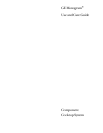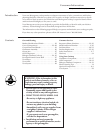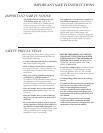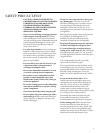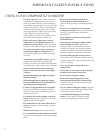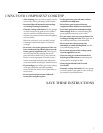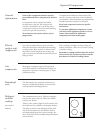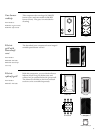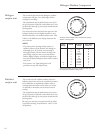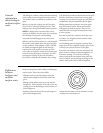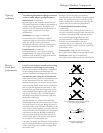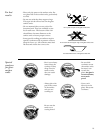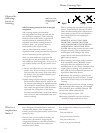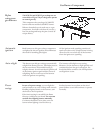
IMPORTANT SAFETY INSTRUCTIONS
6
USING YOUR COMPONENT COOKTOP
• Use proper pan size—this cooktop system has
components equipped with electric surface
units or gas burners. Select cookware having
flat bottoms large enough to cover the selected
surface unit or burner. The use of undersized
cookware will expose portions of the surface
units or gas burners to direct contact and may
result in ignition of clothing. Proper
relationship of cookware to the surface unit or
the burner will also improve efficiency.
• Only certain types of glass, glass/ceramic,
earthenware or other glazed containers are
suitable for cooktop service; others may break
because of the sudden change in temperature.
• Never leave the surface units or gas burners
unattended at high heat settings. Boilovers
cause smoking and greasy spillovers that may
catch fire.
• To minimize the possibility of burns, ignition
of flammable materials and spillage, the
handles of cookware should be turned without
extending over nearby surface units or burners.
• Always turn the electric surface unit or gas
burner controls off (O) before removing the
cookware.
• Watch foods being fried at high or medium-
high heat settings.
• When flaming foods are under the exhaust
hood, turn the hood fan off. The hood fan, if
operating, may spread the flame.
• Foods for frying should be as dry as possible.
Frost on frozen foods or moisture on fresh
foods can cause hot fat to bubble up and over
the sides of the pan.
• Use little fat for effective shallow or deep fat
frying. Filling the pan too full of fat can cause
spillovers when food is added.
• If a combination of oils or fats will be used in
frying, stir together before heating, or as fats
melt slowly.
• Always heat fat slowly, and watch as it heats.
• Use a deep-fat thermometer whenever possible
to prevent overheating fat beyond the smoking
point.
• Be sure the downdraft vent grille is not
covered. Be sure the filter is in place. Its
absence during cooking could damage blower
parts.
• Do not cover or block the area around the
cooktop system knobs. This area must be kept
clear for proper ventilation and burner
performance.
• Keep all plastics away from cooktop surface
units and burners.
• Do not operate the halogen/radiant surface
units if the glass is broken. Spillovers or
cleaning solution may penetrate a broken
cooktop and create a risk of electrical shock.
Contact a qualified technician immediately
should your glass cooktop become broken.
• Avoid scratching the glass cooktop surface.
The cooktop can be scratched with items such
as sharp instruments, rings or other jewelry and
rivets on clothing.
• Never use the glass cooktop surface as a
cutting board.
• Do not place or store items on top of the glass
cooktop surface when it is not in use.
• Do not stand on the glass cooktop.
• Be careful when placing spoons or other
stirring utensils on the glass cooktop surface
when it is in use. They may become hot and
could cause burns.
• Use care when touching the cooktop. The glass
surface of the cooktop will retain heat after the
controls have been turned off.
• To avoid possible damage to the cooking
surface, do not apply Cooktop Cleaning
Cream to the glass surface when it is hot.



